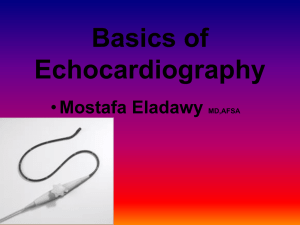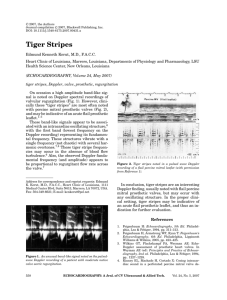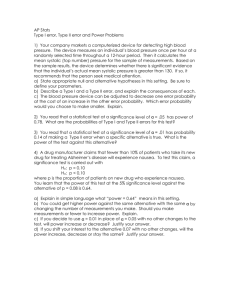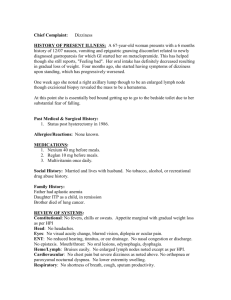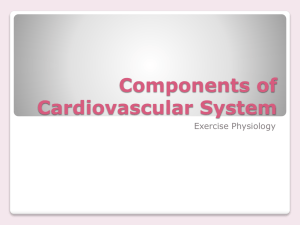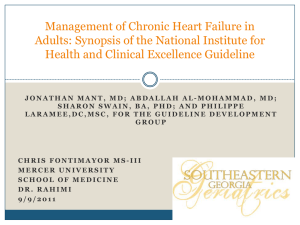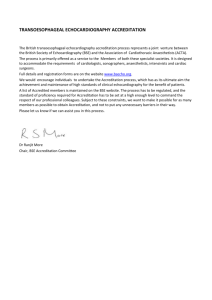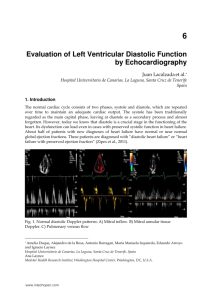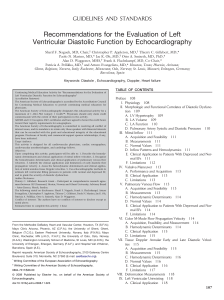Echocardiography curriculum
advertisement
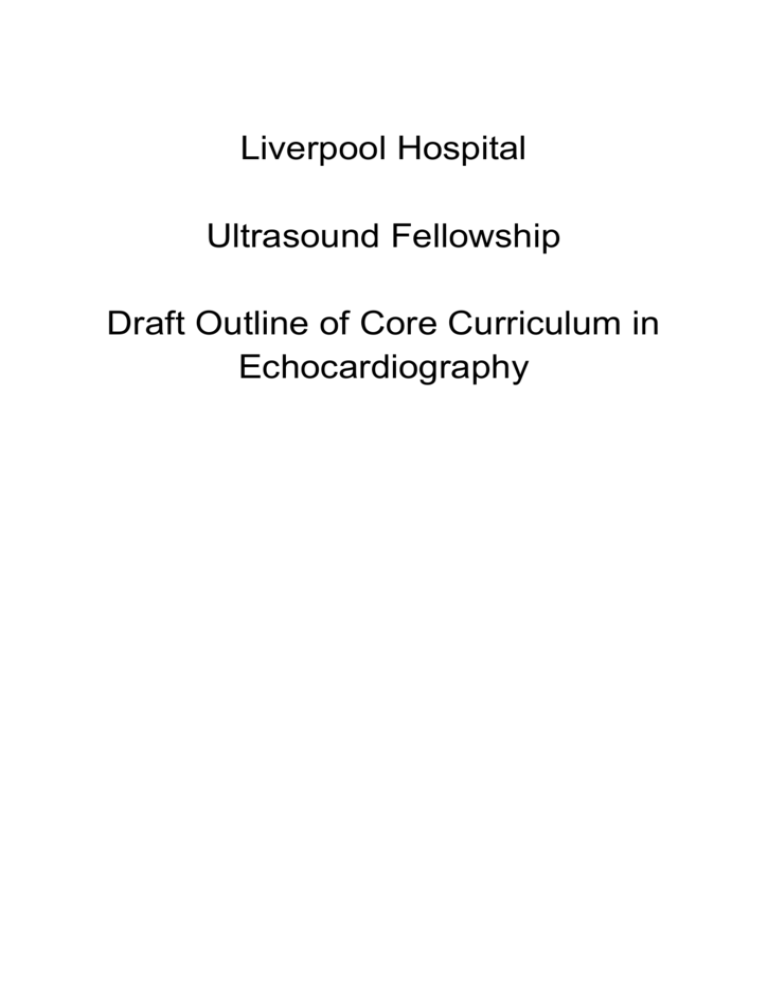
Liverpool Hospital Ultrasound Fellowship Draft Outline of Core Curriculum in Echocardiography Components In hospital lectures “HART” scan PGCertCU or PGDipCU Bedside teaching Completion of 50 Studies and documentation with a logbook Objective Attain to a substantial standard basic peri operative echocardiography as outlined by the ACC/AHA Clinical Competence on Echocardiography Statement. This comprises of basic skills, peri operative cognitive skills and technical skills. It is anticipated that, at the end of the cardiovascular module, the fellow is competent with making a peri operative diagnosis of myocardial ischemia and infarction, the peri operative assessment of hemodynamics and ventricular function, and the peri operative diagnosis and management of cardiovascular collapse. Basic Skills ● Knowledge of physical principles of echocardiographic image formation and blood flow velocity measurements. ● Knowledge of instrument settings required to obtain an optimal image. ● Knowledge of normal cardiac anatomy. ● Knowledge of fluid dynamics of normal blood flow. ● Knowledge of pathological changes in blood flow due to acquired heart disease. Peri operative Cognitive Skills ● Knowledge of the equipment handling, infection control, and electrical safety recommendations associated with the use of TTE. ● Knowledge of the indications and the absolute and relative contraindications to the use of TTE. ● General knowledge of appropriate alternative diagnostic modalities, especially transthoracic and epicardial echocardiography. ● Knowledge of the normal cardiovascular anatomy as visualized by TTE. ● Knowledge of commonly encountered blood flow velocity profiles as measured by Doppler echocardiography. ● Detailed knowledge of the echocardiographic presentations of myocardial ischemia and infarction. ● Detailed knowledge of the echocardiographic presentations of normal and abnormal ventricular function. ● Detailed knowledge of the physiology and TTE presentation of air embolization. ● Knowledge of native valvular anatomy and function, as displayed by TEE. ● Knowledge of the major TEE manifestations of valve lesions and of the TEE techniques available for assessing lesion severity. ● Knowledge of the principal TEE manifestations of cardiac masses, thrombi, and emboli; cardiomyopathies; pericardial effusions and lesions of the great vessels. Peri operative Technical Skills ● Ability to operate the ultrasound machine, including controls affecting the quality of the displayed data. ● Ability to perform a TEE probe insertion safely in the anesthetized, intubated patient. ● Ability to perform a basic TEE examination. ● Ability to recognize major echocardiographic changes associated with myocardial ischemia and infarction. ● Ability to detect qualitative changes in ventricular function and hemodynamic status. ● Ability to recognize echocardiographic manifestations of air embolization. ● Ability to visualize cardiac valves in multiple views and recognize gross valvular lesions and dysfunction. ● Ability to recognize large intracardiac masses and thrombi. ● Ability to detect large pericardial effusions. ● Ability to recognize common artifacts and pitfalls in TEE examinations. ● Ability to communicate the results of a TEE examination to patients and other health care professionals and to summarize these results cogently in the medical record. Syllabus Section 1: General Principles of Cardiac Ultrasound I. Basic Principles of Ultrasound A. Nature of ultrasound 1. Propagation: compression and rarefaction 2. Differentiation between audible sound and ultrasound B. Frequency, wavelength, propagation speed in tissues C. Properties of ultrasound waves 1. Amplitude 2. Power 3. Intensity 4. Pressure D. Propagation of ultrasound through tissues 1. Average speed of sound in tissues 2. Reflection a. Acoustic impendance b. Reflection and transmission at specular interfaces c. Scattering 3. Refraction 4. Attenuation a. Definition and sources of attenuation b. Variation with frequency c. Effects on images 5. Useful diagnostic frequency range (penetration vs spatial resolution) II. Transducers A. Piezoelectric effect B. Transducer construction and characteristics 1. Piezoelectric element 2. Damping (due to backing material behind the element) 3. Impedance matching layer(s) C. Sound beam formation 1. Near and far-field (Fresnel and Fraunhofer Zones) 2. Dependence on frequency, transducer size, and bandwidth D. Focusing method: depth, point of maximal intensity, focal area 1. Methods of focusing (lens, curved element, electronic, mirrors) 2. Focal zone characteristics E. Selection of a transducer (tsdr) 1. Size and shape (area or diameter of tsdr face) 2. Frequency a. Resolution (ability to distinguish structures closely related in space as separate) b. Penetration 3. Focusing characteristics a. Fixed focal length with acoustic lens (single element) b. Variable focal length F. Arrays 1. Elements: Liner, phased, annular 2. Beam steering 3. Beam focusing III. Imaging Principles of Ultrasound A. Display modes (advantages and limitations) - A-mode, B-mode, M-mode, 2D B. Instrumentation 1. Pulsing characteristics 2. Output power 3. Receiver overall gain 4. Receiver swept gain - Time gain compensation (TGC), Lateral gain compensation (LGC) 5. Near gain 6. Reject - filtering out all echoes below a certain predetermined amplitude 7. Damping: adjusts strength of transmitted signal 8. Filter (effect on displayed signal) 9. Signal processing C. Factors influencing 2D-image display and sharpness 1. Analogue and digital signal and scan converters 2. Digital systems: binary system, storage capacity 3. Process of image storage 4. Factors affecting image sharpness and spatial resolution 5. Display devices D. Scanning speed limitations 1. Pulsing characteristics (pulse repetition frequency) 2. Frame rate and time to generate one frame 3. Number of lines per frame 4. Sector angle (field of view) 5. Depth to be imaged 6. Temporal resolution E. Artifacts and pitfalls of imaging 1. Reverberations 2. Aliasing 3. Ghosting 4. Mirror images 5. Near field clutter 6. Range ambiguity 7. Refraction 8. Shadowing 9. Side lobes IV. Biologic Effects of Ultrasound and Safety A. Dosimetric quantities 1. Pressure, intensity, power and area 2. Acoustic exposure B. Biological effects 1. Cavitation 2. Heat C. Electrical and mechanical hazards VI. Basic Principles of Doppler A. Physical principles 1. Doppler effect (as related to sampling RBC movement) 2. Doppler equation 3. Range of Doppler shift frequencies 4. Factors influencing magnitude of Doppler shift a. Transducer frequency (transmitted frequenty) b. Angle of beam incidence c. Flow velocity d. Frequency conversion B. Instrumentation 1. Differences between pulsed and continuous wave Doppler (pro/cons) Pulsed Doppler Continuous wave (1) Range discrimination and sample (1) Range ambiquity volume(s) (2) High velocity measurement capability (2) Aliasing 2. Spectral analysis and display 3. Color flow imaging 4. Tissue imaging principles and information display Section 2: The Echo Exam I. Exam A. Basic imaging principles 1. Tomographic imaging 2. Nomenclature of standard views 3. Image orientation 4. Technical quality B. Transducer positions, views 1. Parasternal - Long axis of LV, Short axis of LV, RV inflow and outflow views 2. Apical – 4 chamber view, 2 chamber view, 3 chamber view (Long axis) 3. Suprasternal notch 4. Subxiphoid C. M-Mode echo 1. Aortic valve and left atrium 2. Mitral valve 3. Left ventricle D. Anatomic basis of 2D-echo 1. Orientation of images (terminology and display) 2. Left ventricular wall segments (as recommended by the ASE) 3. Coronary artery distribution E. Principles of echo measurements 1. M-mode 2. 2D-echo II. Anatomy and Physiology A. Left ventricle 1. Dimensions, area, volumes 2. LV mass, wall thickness 3. Global systolic function 4. Regional systolic function B. Right ventricle 1. Dimensions, area, volumes 2. Global systolic function 3. Echo findings with right ventricular volume overload 4. Echo findings with right ventricular pressure overload 5. Moderator band C. Left atrium 1. Dimensions, area, volumes 2. LA function D. Right atrium E. Ventricular septum & Causes of “paradoxical” septal motion F. Atrial septum G. LV outflow tract H. Pulmonary veins I. Inferior and superior vena cava J. Great vessels 1. Aorta - annulus, Sinuses of Valsalva, ST junction, Ascending aorta, arch, Descending aorta 2. Pulmonary artery - Main pulmonary artery, Bifurcation, Right and left pulmonary arteries K. Coronary sinus L. Coronary arteries M. Mitral valve apparatus - Leaflets, Chordae tendinae, Annulus, Scallops, Papillary muscles N. Aortic valve - Leaflets, commissures, annulus O. Tricuspid valve - Leaflets (anterior, septal, posterior), Papillary muscles P. Pulmonic valve III. Technique A. Use of equipment controls B. Recognition of technical artifacts C. Recognition of setup errors D. Use of contrast agents E. Provocative manoeuvres IV. Arrhythmias and Conduction Disturbances A. Production of wall motion abnormalities B. Effect on valve motion C. Effect on Doppler flow velocity waveforms Section 3: Hemodynamics Derived from Echo-Doppler I. Basic Principles A. Laminar vs disturbed (turbulent) flow B. Flow velocity profiles II. Principles of Volume and Flow Measurement A. Cardiac output 1. Doppler methods a. Stroke volume (SV) =Area (CSA) X stroke distance (TVI) b. Cardiac output (CO) = SVx HR c. Potential sites for measurement – LVOT, RVOT, Mitral annulus 2. From LV volume (2D-echo) B. Regurgitant volume (RV) and regurgitant fraction (RF) 1. RV = volume of blood that regurgitates through incompetent valve 2. RF = fraction of total stroke volume that regurgitates through an incompetent valve 3. Values for RF a. Normal or trivial regurg <20% b. Mild regurg 20-30% c. Moderate regurg 30-50% d. Severe regurg >50% III. Normal Antegrade Intracardiac Flows A. Left ventricular outflow 1. Apical 5-chamber outflow 2. Normal values B. Right ventricular outflow 1. Parasternal short axis view 2. Sample volume in RVOT or proximal PA 3. Normal values C. Left ventricular inflow 1. Apical 4-chamber-view 2. Normal values at mitral leaflet tips (age-dependent) 3. Normal values at mitral annulus (for cardiac output) D. Pulmonary venous flow 1. Apical 4-chamber view 2. Sample volume 1-2 cm into R-superior vein 3. Normal values E. Right atrial filling IV. Assessment of Intracardiac Pressures A. Bernoulli equation 1. 2. Assumptions 3. Modified Bernoulli equation 4. Simplified Bernoulli equation B. Applications 1. Valvular aortic, pulmonic stenosis 2. Subvalvular aortic, pulmonic stenosis 3. RV or PA systolic pressure = 4 (TR velocity)2 + RA pressure 4. PA diastolic pressure = 4 (PR end-diastolic velocity)2 + RA pressure 5. LA pressure = Systolic BP – 4 (MR systolic velocity)2 6. RV systolic pressure = Systolic BP – 4 (VSD velocity)2 C. Left ventricular diastolic pressure D. Pulmonary artery pressure/right ventricular pressure 1. M-mode findings 2. Pulmonary acceleration time 3. Tricuspid regurgitant jet method 4. Pulmonic regurgitant jet method 5. Systolic time intervals E. Right atrial pressure V. Continuity Equation A. Basic principle 1. Conservation of mass: Flow proximal to a valve equals flow across the valve a. Flow proximal = flow across b. (Area1) (TVI1) = (Area2) (TVI2) B. Aortic valve area by continuity equation C. Mitral valve area by continuity equation Section 4: Systolic Function I. Determinants of LV Performance A. Contractility (inotropic state of myocardium) 1. Well-defined concept in vitro (velocity of shortening of isolated muscle strip) 2. More difficult to measure clinically (dependent on preload and afterload) B. Preload 1. Fiber length at onset of contraction 2. Frank-Starling relationship C. Afterload 1. Counter force to contraction which halts shortening when it equals the force generated of the myocardium 2. Determinants a. Ventricular volume and pressure b. Arterial resistance c. Aortic impedance d. Mass of blood in aorta e. Viscosity of blood II. Global LV Systolic Function A. Measurements 1. Ejection phase indices a. Indices 1) Ejection fraction (EF) 2) Fractional shortening (FS) 3) Velocity of circumferential fiber shortening (Vcf) 4) Cardiac output (CO) and stroke volume (SV) b. Potential limitations 1) Requires high-qualify images (endocardial definition) 2) Some methods require no major shape distortion 3) Beam orientation (avoid oblique measurements) 4) Limited frame rate 5) Foreshortening of long axis of LV 6) Influence of loading conditions 2. Non-ejection phase indices a. Systolic time intervals b. dP/dt c. Acceleration time d. Pressure–volume analysis 3. Indirect methods (simple confirmatory methods) a. Mitral E-point septal separation (>8 mm ~ EF <50%) b. Aortic root motion (normally >14 mm during systole) c. Descent of cardiac base (normally moves 10-15 mm) d. Sphericity of left ventricle e. TVI of LVOT and pulmonary artery velocities III. Regional systolic function References Outline of Core Curriculum in Echocardiography American Society of Echocardiography ACC/AHA Clinical Competence Statement on Echocardiography 2003 Transthoracic Echocardiography and Anaesthesia MICHAEL VELTMAN
